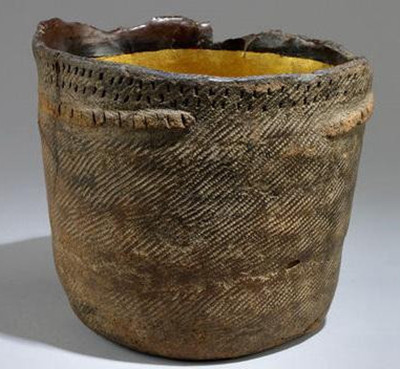In fact, some of the very early ones, some of those ones that are now dated to about 14,000 years ago-there's black incrustations, and its that carbonised material that has been dated-we think they were probably used for cooking up some vegetable materials?
事實上有些器皿中的黑色陳淀物差不多了一萬四千年歷史了。這些黑色碳化物已經被科學家年代定位了,我們在猜想也許當初繩紋人是在烹飪一些蔬菜湯?
Perhaps they were cooking up fish broths? And it's possible they were cooking up nuts, using a wide range of nuts-including acorns-that you need to cook and boil for a long time before you can actually eat them.'
或者是鮮魚湯?也有可能是在燉堅果,像橡子之類的,那種東西可真是要熬很久時間可以吃。”
I think that this is a really interesting point-that pots change your diet. New foods become available and useable only once they can be boiled. Heating shellfish in water forces the shells to open, making it easier to get at the contents, but also, and no less importantly, it sorts out which ones are bad-bad ones stay closed. It's alarming to think of the trial-and-error involved in discovering which foods are in fact edible-there must have been plenty of horrible accidents along the way-but it's a process that was going on all over the world.
說起來真是有趣,這種罐頭缽頭可以改變你的飲食。通過煮沸,就出現了很多可食用的新食物了。把貝殼類水煮一下,殼就打開了,吃里頭的肉就輕而易舉。而且,同樣重要的是,人類是摸著石頭過河,一路試吃試過來的。歷史上不乏第一個吃螃蟹的人的例子。不過在這過程中,這種盲目性很強的冒險行為肯定導致了相當多的意外事件;然而這在全世界各地都是一種不可避免的過程。
The Jomon hunter-gatherer way of life, enriched and transformed by the making of Jomon pottery, didn't radically change for over 14,000 years.
繩紋陶器的制作,豐富與改造了繩紋人這種狩獵與采集的生活方式;而后在一萬四千年的漫漫歲月中,一切沒有多大的改變。
Although the oldest pots in the world were made in Japan, the technique didn't spread from there.
雖說日本人制造出世界上最古老的陶罐陶缽,這種技術并不能從那里蔓延開來。
Pottery seems to have been invented in different places at different times right across the world. The first pots known from the Middle East and North Africa were made a few thousand years after the earliest Jomon pots, and in the Americas it was a few thousands of years after that.
制陶似乎是在世界各地不同時期、不同地區獨立發明的。比最早期繩紋盆晚了幾千年,在中東與北非出現了當地第一批陶器,而在美洲,那是還要再晚幾千年的事。
But almost everywhere in the world, the invention of the pot was connected with new cuisines and a more varied menu.
然而在全世界各地,鍋碗瓢盆的出現,毫無例外地促成了新烹飪與人類更加豐富多樣的菜譜。
Nowadays Jomon pots are used as cultural ambassadors for Japan in major exhibitions around the world. Most nations look back to imperial glories or invading armies-and I think it's extraordinary that a technologically, economically powerful nation like Japan proudly places the very origins of its identity in the early hunter-gatherers.
如今繩紋陶器已經充當起日本文化大使的角色,在世界各地的大型展覽與人們見面。大多數國家都以自己帝國時代的輝煌或軍隊的入侵略擴張為榮,我認為像日本這種技術領先、經濟實力強大的民族可以很自豪地向世人展示最早期的狩獵采集者身份,無疑是件了不起的事。
As an outsider, I find the meticulous attention to detail and the patterning of the surface, and the long continuity of Jomon traditions, already very Japanese. Professor Takashi Doi again:
作為一個局外人,我發現繩紋陶品上那種對細節一絲不茍還有精致的表面圖案,再加上長期連續的繩紋傳統,真是相當的日本。隆土井教授說道:
'Japan has the longest pottery-making tradition in the world. The fine porcelains made by Japan's top craftsmen and women today have an inheritance lasting over 17,000 years. Jomon pots and culture have great resonance for many Japanese people today, perhaps because it speaks of the distinctive nature of Japanese culture that often stresses continuity through change.'
“日本擁有世界上最長的制陶傳統。由日本頂尖工匠與婦女們制造出精細瓷器是一種長達一萬七千年的傳統。繩紋陶器與文化在許多當今的日本人民心頭仍然可以產生強烈的共鳴,也許是因為它敘說了日本文化的獨特性質,強調改變需要在傳承性與連續性中進行。”
But the story of our small Jomon pot doesn't end here, because I haven't yet described to you what is perhaps the most extraordinary thing of all about it-that the inside is, when you look, carefully lined with lacquered gold leaf.
但是我們這小小繩紋缽的故事并不是就這么結束了。因為我還沒開始告訴你這件物品中最不尋常的事情呢。來瞧瞧這缽的里頭,仔細瞧瞧這精心貼上的漆金箔內襯。












